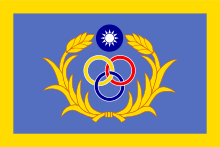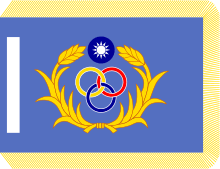Taiwan Garrison Command
| Taiwan Garrison Command | |
|---|---|
 | |
| Active | September 1945 - 1 August 1992 |
| Country |
|
| Branch |
|
| Type | Secret police / state Security body |
| Role | Anti-government elements suppression |
| Part of |
|
| Garrison/HQ | Taipei City |
| Nickname(s) | Ching-tsung (警總) |
| Commanders | |
| Notable commanders | zh:彭孟緝, zh:陳守山, zh:周仲南 |
| Insignia | |
| Logo of Taiwan Garrison Command |
 |


The Taiwan Garrison Command (Chinese: 臺灣警備總司令部; pinyin: Táiwān Jǐngbèi Zǒngsīlìngbù) was a secret police/state security body which existed under the Republic of China Armed Forces on Taiwan. The agency was established at the end of World War II, and operated throughout the Cold War. It was disbanded on 1 August 1992.[1]
Taiwan Garrison Command was an equivalence to the unified command in the United States of America. It was commanded by a three-star general and consisted with officers or enlisted persons from Army, Marine Corps, Military Police, Political Warfare, or Intelligence Bureau; and members from National Police Agency of the Ministry of the Interior, or civilian recruits from other colleges after special training. Because of security reasons, its military draftees were tagged and interviewed before usual military recruit trainings.
While operational, this military command was responsible for suppressing activities viewed as promoting democracy and Taiwan independence. The reputation of Taiwan Garrison Command is so infamous that its name symbolizes the authoritarian rule to which Taiwan was once subjected.[2]
History
The Taiwan Provincial Garrison Command (台灣省警備總司令部) was established on 1 September 1945 at Chongqing, with Chen Yi as its first commanding general. On the same day, the Governor Office of Taiwan Province (zh:台灣省行政長官公署; 1945-09-01—1947-05-16) was formed and headed by Chen Yi as well.
This command's major responsibilities included the repatriation of all Japanese nationals in Taiwan, transfer of authority over Taiwan to the Republic of China government, and maintenance of law and order. The agency was renamed as the All-Taiwan Provincial Garrison Command (台灣全省警備總司令部) and relocated to Taipei in 1947 and commanded by Peng Meng-chi (zh:彭孟緝).
In the beginning of 1949, it was re-designated as "Taiwan Provincial Garrison Command" and headed by Chen Cheng. On 20 May 1949, Chen Cheng, then the Chair of Taiwan Provincial Government and the Commanding General of Taiwan Provincial Garrison Command, declared martial law in Taiwan.[3] Immediately, the Taiwan Provincial Garrison Command was to enforce Martial Law within its area of responsibility, excluding Kinmen and Matsu of Fujian Province, which had been under Martial Law since 10 December 1948.
On 15 August 1949, it was further split into Southeast Military Governor Office (zh:東南軍政長官公署; 1949-08-15—1950-03-16) and Taiwan Provincial Security Command (台灣省保安司令部), which was again commanded by Peng Meng-chi. The Southeast Military Governor Office, headed by Chen Cheng, had control of four provinces: Jiangsu, Chekiang, Fujian and Taiwan; and was directly responsible for the systematic killing of thousands of Taiwanese social elites, as part of what became known as the February 28 Incident.
In 1958, the Republic of China government underwent a series of restructuring, and Taiwan Provincial Security Command was merged with Taiwan Provincial Civil Defense Command (台灣省民防司令部), Taiwan Defense Command (台灣防衛總司令部), and Taipei Garrison Command (台北衛戌總司令部) and renamed Taiwan Garrison Command under the command of Huang Chen-chiu, the commander of the defunct Taipei Garrison Command.
Taiwan Garrison Command continued to enforce Martial Law until 14 July 1987, the lift of Martial Law over Taipei City, Kaohsiung City and Taiwan Province by a presidential order from Chiang Ching-Kuo. On 30 April 1991, President Lee Teng-hui declared the termination of the Period of Communist Rebellion and Taiwan Garrison Command again lost its other lawful justification.
This military organization was transformed and restructured into the "Coast Guard Command and Military Reserve District Command" on 1 August 1992.[1][4] The move effectively disbanded the Taiwan Garrison Command, under quiet orders from then President Lee Teng-hui.
- Coastal patrol duties were assumed by the Coastal Guard Command; and were later passed to the newly reformed Coast Guard Administration.
- Subordinate units for military reserve mobilization were regrouped into Military Reserve District Command, and later, the Reserve Command.
- Electronic intelligence units[5] for telephone-wire-tapping and radio surveillance were assigned to the Military Intelligence Bureau.[6][7]
- Duties to suppress unauthorized radio broadcasting were then transferred to the Telecommunication Directorate of the Ministry of Transportation and Communications.
- Functions for imprisoning political and dissents activists and re-educating gangsters without trial were terminated. All prison facilities were transferred to either the Military Police Command, or to the Culture Establishment Commission for memorial purposes.[8][9]
- Task of riot control were shared by the National Police Agency and the Military Police Command.
- The defense of Taipei City were taken over by the Military Police Command.[10][11]
- The responsibility for censoring and confiscating questionable publications or newspapers[12] went to the Government Information Office; such functions were later terminated after the abolishment of "the Law of Publications."[13][14]
It has been recently argued that the declaration of Martial Law in Taiwan is unconstitutional,[3] by Hsieh Chung-min (謝聰敏), a former political prisoner and a former legislator of Democratic Progressive Party. Hsieh is preparing such a constitutional appeal to the Constitutional Court on behalf of two fellow political prisoners, Hung Wu-hsiung (洪武雄)and Hu Xue-kuo (胡學古).
Involvement
Although a division under the military, TGC actually functioned as a secret police organization. It was actively involved in suppression of members suspected by the government to be sympathetic to Communist causes and pro-Taiwan Independence activists, which included many pro-democracy activists as well. Here are several famous cases: Peng Ming-min, Taiyuan Incident, and Kaohsiung Incident. Also, it was rumored to have been involved in many politically motivated assassinations/murders, such as the murder of Lin Yi-hsiung's family and the murder of Dr. Chen Wen-chen.[4]
See also
References
- 1 2 許紹軒 (17 May 2008). 小檔案/警總 戒嚴時代「東廠」 (in Chinese). Liberty Times. Retrieved 2008-06-13.
- ↑ 許紹軒 (17 May 2008). "扁視察會餐 國防部請媒體吃「警總」便當" (in Chinese). Liberty Times. Retrieved 2008-06-13.
- 1 2 李心怡 (2008-06-26). "戒嚴令根本無效 台灣人被裝肖仔" (in Chinese). New Taiwan News Weekly. Retrieved 2008-06-30.
- 1 2 邱燕玲 (21 April 2008). "仍有政治檔案 至今未尋獲" (in Chinese). Liberty Times. Retrieved 2008-06-13.
- ↑ 科學工業園區電腦媒體進出口登記查驗作業要點. 科學工業園區管理局 (in Chinese). 1983. Archived from the original on 2009-04-25. Retrieved 2008-06-13.
- ↑ 宋朝欽 (2008-06-08). "警調監聽手機 沒人管" (in Chinese). 中國時報. Retrieved 2008-06-13.
- ↑ 呂昭隆 (2008-06-08). "解嚴後 情治監聽 姚祖德控管18年" (in Chinese). China Times. Retrieved 2008-06-13.
- ↑ 羅添斌 (24 May 2008). "警總單位 已移交或改制" (in Chinese). Liberty Times. Retrieved 2008-06-13.
- ↑ 邱紹雯 (24 May 2008). "坪林招徠遊客/前警總職訓中心 擬改建五星監獄飯店" (in Chinese). Liberty Times. Retrieved 2008-06-13.
- ↑ "Garrison Military Police". Reserve Military Police in TAIWAN. Retrieved 2008-06-13.
- ↑ 戍衛憲兵. 導覽資料庫 (in Chinese). 中華民國後備憲兵論壇. Retrieved 2008-06-13.
- ↑ 曾韋禎 (9 March 2008). "我是抓耙仔--一名台大中文系女學生之「追究自己」" (in Chinese). Liberty Times. Retrieved 2008-06-13.
- ↑ 薛理桂 (February 1999). 出版法廢止對我國圖書資料蒐集與保存之衝擊與因應. 國家圖書館館刊 (in Chinese). 國家圖書館. Retrieved 2008-06-13.
- ↑ zh:中華民國行政院新聞局. 出版法廢止後,媒體將無所限制,是否會影響國家安全、社會安寧?. 出版業務Q&A (in Chinese). Archived from the original on 2011-07-16. Retrieved 2008-06-13.
External links
| Wikimedia Commons has media related to Taiwan Garrison Command. |
- Forum of Garrison, Military District, Coastal Patrol and Reserve(in Taiwanese Mandarin)
- Republic of China Military Police Forum(in Taiwanese Mandarin)